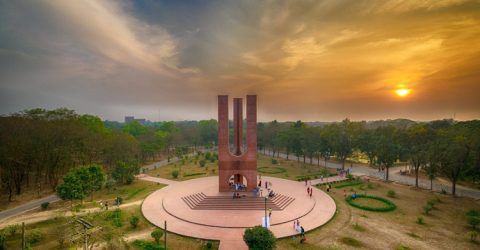
The Muslim League is not only an important party in the political history of South Asia but also a big chapter, a factory for making true politicians. Why is the Muslim League established in the beautiful Nawab Bari Ishrat Manzil on the initiative of Nawab Salimullah in the attic today? In 1765, for the convenience of exploitation, the British administration started the partition of Bengal by separating Bihar and Odisha from Bengal. On 16 October 1905, Bengal was divided for the second time. The new province of Bengal was formed with East Bengal, Assam and Tripura and Dhaka as its capital. The problem with this was with Calcutta-centric bengalis. Bengali was then central to Kolkata, the province was under the control of the wealthy Hindu zamindars. As a result of the partition of Bengal, the fertile background and exploitation of Hindu zamindars will be lost by the slave Muslims. As a result, a respected person like Rabindranath Tagore did not hesitate to oppose the partition of Bengal, let alone others.
Later the Hindu nationalist leaders started the movement for partition of Bengal. The session of the All India Muslim Education Conference began in Dhaka on Thursday, December 27, 1906. The program started at 10 am in Mon Bagan of Nawab Salimullah in Shahbagh area. The conference was held in a specially constructed pandal. About eight hundred delegates from different states of India attended the conference. Nawab Salimullah was the convener of the reception committee at the conference. The source of the discussion was the plan proposed by Nawab Salimullah. Nawab Vika-ul Mulak presided over the political session in support of Nawab Salimullah’s proposal and Mazharul Pakshi Haq. He spoke in Urdu. At the meeting Nawab Sir Salimullah raised a formal proposal for the establishment of the Muslim League. Hakim Ajmal Khan, Maulana Zafar Ali Khan, Shah Abdullah and Maulana Mohammad Ali supported the proposal. Thus, on 30 December 1906, the All India Muslim League emerged as a political organization of the Muslims of India. The twentieth session of the All India Mohammedan Educational Conference was attended by about 3000 leading Muslim leaders from all over India.
The main purpose was to protect the interests of Muslims. Nawab Salimullah mortgaged his property and incurred huge expenses at the conference, as well as working tirelessly to establish the foundation of the Muslim nation, virtually bankrupting his zamindari. On 12 December 1911, the Congress-backed movement of Hindu leaders to abolish the Partition of Bengal succeeded. It is true that the partition of Bengal and its abolition in the political and social sphere
Religion-based nationalism gave rise to open conflict. Interestingly, the same Hindu nationalist leaders who started the abolitionist movement in 1911 during the partition of Bengal for the third time in 1947, were seen on the opposite side of Husain Shaheed Suhrawardy’s proposal for a united Bengal. With the loss of Bengal’s limbs at this time, Muslim leaders like Moulvi Surabdi were more influential than the united Bengal, they have proved that by favoring Hindustan with partial Bengal under the leadership of Mahatma Gandhi and Jawaharlal Nehru.
The unique homeland of the Muslims was acquired through continuous struggle. If it were not for the Muslim League, there would be no Pakistan, if not Pakistan, there would be Bangladesh. It is a matter of discussion. On the other hand, under the leadership of Bangabandhu Sheikh Mujibur Rahman in exchange for the blood of 30 lakh martyrs in 1971, we are today a proud independent nation. There is no denying that the independence movement reached its goal on August 14, 1947, which served as the primary step towards the attainment of ultimate independence. The mentality of constantly underestimating the self-sacrificing great human beings from 1757-1947 behind building the first step of independence should be avoided. The architect of Bangladesh Bangabandhu Sheikh Mujibur Rahman was one of the members of the independence movement. On March 25, 1969, Yahya Khan, a controversial figure in Pakistani politics, came to power as a military administrator in an undemocratic process. He directed to freeze the bank accounts of crores of taka. Nawab Salimullah’s successor, Nawab Khwaja Hasan Ashkari, had a magnificent Tetla office at the Shahbagh intersection in Dhaka.
Despite internal differences of opinion, the leaders and activists of the garlic party of Muslim nationalism and national interest are uncompromising and disinterested which is rare in the politics of the present country.
Kazi Abul Khair was born on January 1, 1947 in Charhujuri village in Baligaon union in Feni district Kazi into an aristocratic Muslim family. His father was Moulvi Kazi Rahman and Mother Angur Nessa. His uncle Abdul Wahab Miah was an active member of the Muslim League in the then anti-British and independence movement. Activities based on his father and uncle attracted him to politics from an early age. After the death of his father, he joined Ispahani Jute Manufacturing Workers’ Association and became active workers leader. He played various important roles in the labor movement and organization. He is currently the Secretary General of the Central Executive Committee of the Muslim League. Extremely elegant and good-natured Kazi Abul Khair is a highly educated person. In private life he is the father of two sons and three daughters. He visited different countries of the world for political and business reasons.
The writer is the Secretary General of the Central Executive Committee of the Muslim League.




